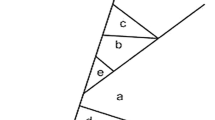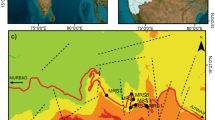Abstract
Complicated geological structures make it difficult to analyze the stability of rock slopes, such as faults, weak intercalated layers or joint fissures. Based on 3D geological modeling and surface block identifying methods, an integrated methodology framework was proposed and realized to analyze the stability of surface blocks in rock slopes. The surface blocks cut by geological structures, fissures or free faces could be identified subjected to the four principles of closure, completeness, uniqueness and validity. The factor of safety(FOS)of single key block was calculated by the limit equilibrium method. If there were two or more connected blocks, they were defined as a block-group. The FOS of a block-group was computed by the Sarma method. The proposed approach was applied to an actual rock slope of a hydropower project, and some possible instable blocks were demonstrated and analyzed visually. The obtained results on the key blocks or block-groups provide essential information for determining potential instable region of rock slopes and designing effective support scheme in advance.
Similar content being viewed by others
References
Goodman R E. Block theory and its application[J]. Geotechnique, 1995, 45(3): 383–423.
Mito Y, Kikuchi K, Hirano I et al. Stochastic block theory for initial support decision of large slope[J]. International Journal of Rock Mechanics and Mining Sciences, 1997, 34(3/4): 202. e1-e19.
Norris R D, Norris J M, Lorenz R D et al. Sliding rocks on Racetrack Playa, Death Valley National Park: First observation of rocks in motion[J]. PLoS One, 2014, 9(8): e105948.
Warburton P M. Vector stability analysis of an arbitrary polyhedral rock block with any number of free faces[J]. International Journal of Rock Mechanics and Mining Science, 1981, 18(5): 415–427.
Goodman R E, Shi G H. Block Theory and Its Application to Rock Engineering[M]. Prentice-Hall, New Jersey, USA, 1985.
Lee I M, Park J K. Stability analysis of tunnel key block: A case study[J]. Tunnelling and Underground Space Technology, 2000, 15(4): 453–462.
Liu J, Li Z K, Zhang Z Y. Stability analysis of block in the surrounding rock mass of a large underground excavation[J]. Tunnelling and Underground Space Technology, 2004, 19(1): 35–44.
Chen S H, Wang W M, Zheng H F et al. Block element method for the seismic stability of rock slope[J]. Journal of Geotechnical and Geoenvironmental Engineering, 2010, 136(12): 1610–1617.
Turanboy A. A geometric approach for natural rock blocks in engineering structures[J]. Computational Geosciences, 2010, 14(4): 26–38.
Kulatilake P H S W, Wang L Q, Tang H M et al. Evaluation of rock slope stability for Yujian River Dam Site by kinematic and block theory analyses[J]. Computers and Geotechnics, 2011, 38(6): 846–860.
Brideau M A, Pedrazzini A, Stead D et al. Threedimensional slope stability analysis of South Peak, Crowsnest Pass, Alberta, Canada[J]. Landslides, 2011, 8(2): 139–158.
Li M C, Liu J, Liu F et al. Method for identifying and analyzing 3D surface blocks of rock mass structures[J]. Journal of Geotechnical and Geoenvironmental Engineering, 2013, 139(10): 1756–1764.
Jafari A, Khishvand M, Rahami H. Developing an algorithm for reconstruction blocky systems in discontinuous media: Three-dimensional analysis[J]. International Journal for Numerical and Analytical Methods in Geomechanics, 2013, 37(7): 661–684.
Zhang Z X, Lei Q H. Object-oriented modeling for threedimensional multi-block systems[J]. Computers and Geotechnics, 2013, 48: 208–227.
Wang S H, Ni P P. Application of block theory modeling on spatial block topological identification to rock slope stability analysis[J]. International Journal of Computational Methods, 2014, 11(1): 1350044.
Zhang Q H. Advances in three-dimensional block cutting analysis and its applications[J]. Computers and Geotechnics, 2015, 63: 26–32.
Li M C, Han Y Q, Wang G et al. 3D multiscale integrated modeling approach of complex rock mass structures[J]. Mathematical Problems in Engineering, 2014, DOI 10. 1155/2014/867542.
Giani G P. Rock Slope Stability Analysis[M]. Balkema Publishers, Netherlands, 1992.
Sarma S K. Stability analysis of embankments and slopes[J]. Journal of the Geotechnical Engineering Division, 1979, 105(12): 1511–1524.
Bafghi A R Y, Verdel T. Sarma-based key-group method for rock slope reliability analyses[J]. International Journal for Numerical and Analytical Methods in Geomechanics, 2005, 29(10): 1019–1043.
Sun J P, Ning Y J, Zhao Z Y. Comparative study of Sarma's method and the discontinuous deformation analysis for rock slope stability analysis[J]. Geomechanics and Geoengineering, 2011, 6(4): 293–302.
Zhong D H, Li M C, Song L G et al. Enhanced NURBS modeling and visualization for large 3D geoengineering applications: An example from the Jinping first-level hydropower engineering project, China[J]. Computers & Geosciences, 2006, 32(9): 1270–1282.
Author information
Authors and Affiliations
Corresponding author
Additional information
Supported by the National Natural Science Foundation of China(No. 51379006 and No. 51321065)and the Program for New Century Excellent Talents in University of Ministry of Education of China( NCET-12-0404).
Rights and permissions
About this article
Cite this article
Li, M., Zhou, S. & Wang, G. 3D identification and stability analysis of key surface blocks of rock slope. Trans. Tianjin Univ. 22, 317–323 (2016). https://doi.org/10.1007/s12209-016-2596-z
Accepted:
Published:
Issue Date:
DOI: https://doi.org/10.1007/s12209-016-2596-z




